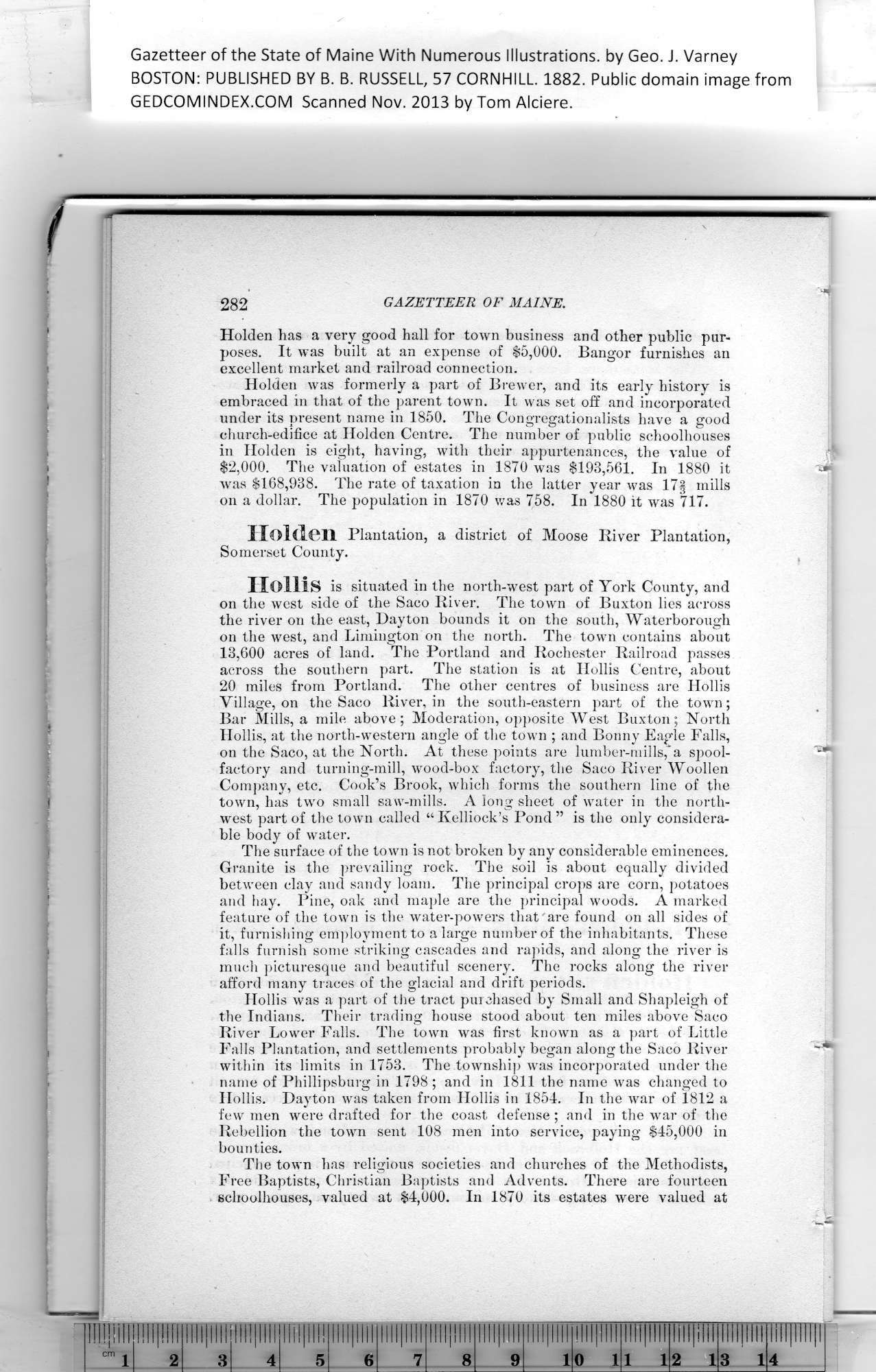|
Gazetteer of the State of Maine With Numerous Illustrations, by Geo. J. Varney
BOSTON: PUBLISHED BY B. B. RUSSELL, 57 CORNHILL. 1882. Public domain image from
282 GAZETTEER OF MAINE.
Holden has a very good hall for town business and other public pur-
poses. It was built at an expense of $5,000. Bangor furnishes an
excellent market and railroad connection.
Holden was formerly a part of Brewer, and its early history is
embraced in that of the parent town. It was set off and incorporated
under its present name in 1850. The Congregationalists have a good
church-edifice at Holden Centre. The number of public schoolhouses
in Holden is eight, having, with their appurtenances, the value of
$2,000. The valuation of estates in 1870 was $193,561. In 1880 it
was $168,938. The rate of taxation in the latter year was 17§ mills
on a dollar. The population in 1870 was 758. In 1880 it was 717.
Holden Plantation, a district of Moose River Plantation,
Somerset County.
Hollis is situated in the north-west part of York County, and
on the west side of the Saco River. The town of Buxton lies across
the river on the east, Dayton bounds it on the south, Waterborough
on the west, and Limington on the north. The town contains about
13,600 acres of land. The Portland and Rochester Railroad passes
across the southern part. The station is at Hollis Centre, about
20 miles from Portland. The other centres of business are Hollis
Village, on the Saco River, in the south-eastern part of the town;
Bar Mills, a mile above; Moderation, opposite West Buxton; North
Hollis, at the north-western angle of the town ; and Bonny Eagle Falls,
on the Saco, at the North. At these points are lumber-mills," a spool-
factory and turning-mill, wood-box factory, the Saco River Woollen
Company, etc. Cook’s Brook, which forms the southern line of the
town, has two small saw-mills. A long sheet of water in the north-
west part of the town called “ Kelliock’s Pond ” is the only considera-
ble body of water.
The surface of the town is not broken by any considerable eminences.
Granite is the prevailing rock. The soil is about equally divided
between clay and sandy loam. The principal crops are corn, potatoes
and hay. Pine, oak and maple are the principal woods. A marked
feature of the town is the water-powers that are found on all sides of
it, furnishing employment to a large number of the inhabitants. These
falls furnish some striking cascades and rapids, and along the river is
much picturesque and beautiful scenery. The rocks along the river
afford many traces of the glacial and drift periods.
Hollis was a part of the tract purchased by Small and Shapleigh of
the Indians. Their trading house stood about ten miles above Saco
River Lower Falls. The town was first known as a part of Little
Falls Plantation, and settlements probably began along the Saco River
within its limits in 1753. The township was incorporated under the
name of Phillipsburg in 1798 ; and in 1811 the name was changed to
Hollis. Dayton was taken from Hollis in 1854. In the war of 1812 a
few men were drafted for the coast defense ; and in the war of the
Rebellion the town sent 108 men into service, paying $45,000 in
bounties.
The town has religious societies and churches of the Methodists,
Free Baptists, Christian Baptists and Advents. There are fourteen
schoolhouses, valued at $4,000. In 1870 its estates were valued at
PREVIOUS PAGE ... NEXT PAGE
This page was written in HTML using a program written in Python 3.2
|
